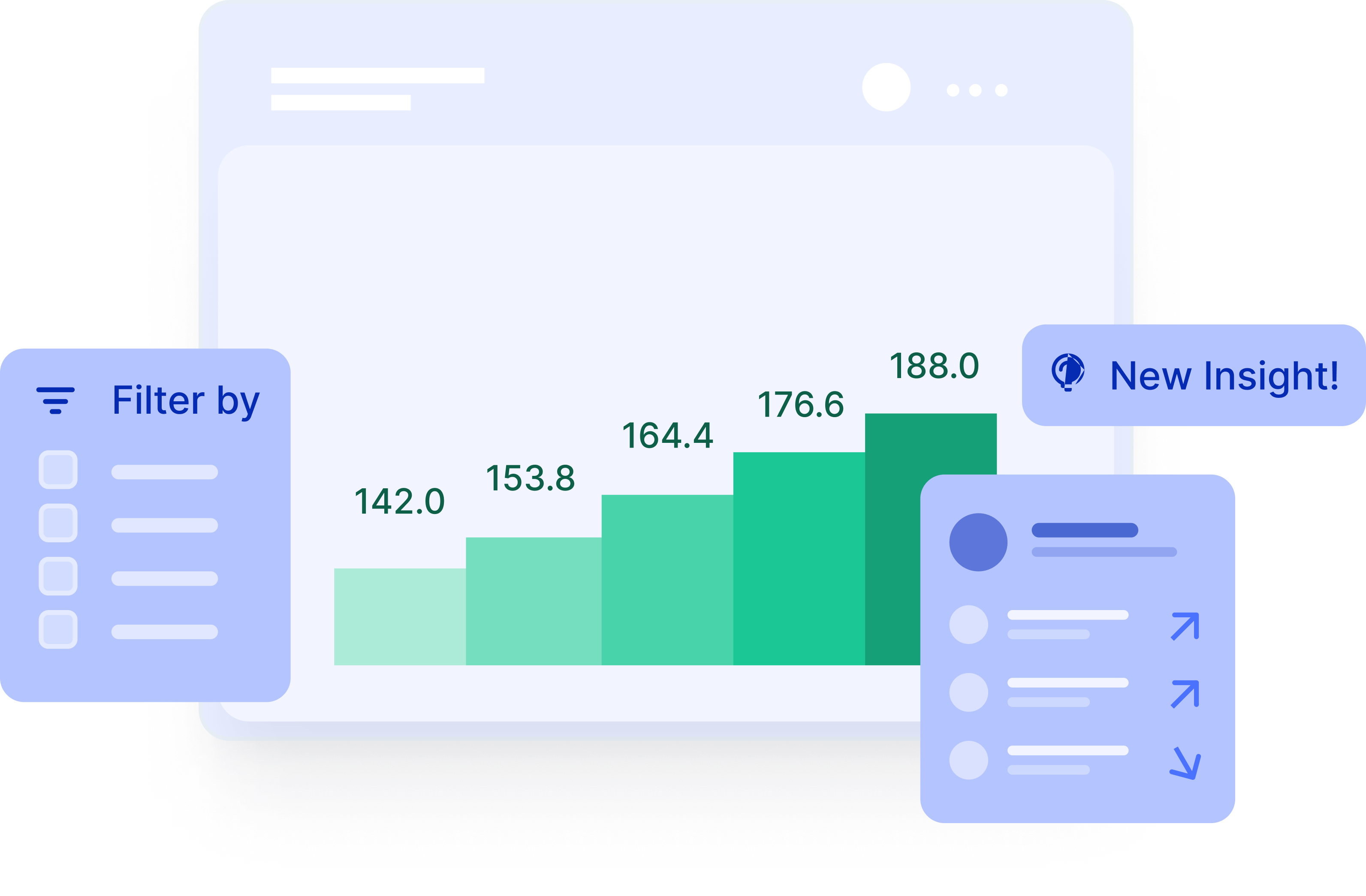The Top 10 RevOps Trends to Watch in 2024

Co-Founder & CTO
Revenue operations trends are constantly evolving as new tools come to the forefront, such as AI-powered automations, and as economic fluctuations take companies in a different direction, altering a company’s revenue needs and focus.
For this reason, staying on top of trends is incredibly important in the RevOps space—what was a trend in 2023 may not have the same weight in 2024.
Whether you already have a dedicated RevOps team or you’re eager to optimize your revenue streams, you’ll be able to move faster this year by learning about the latest RevOps trends for 2024 and beyond.

The top RevOps trends we’re seeing in the market
1. Revenue forecasting in real-time
To stay relevant in the uncertain years ahead, businesses must be agile and ready to adapt quickly to unforeseen changes. That means their go-to-market strategies must be similarly flexible. Therefore, focusing on historical trends and data is of limited use. Leaders must keep a finger on the pulse of their organizations by monitoring trends in near real-time so they can make important decisions in hours and days rather than weeks or months.
While historical trends and insights are the most traditional form of data analytics, the focus is now shifting towards real-time metrics to enhance decision-making. Given how vital real-time analytics are in the era of customer experience, they will play a central role in RevOps.
Thanks to real-time analytics, teams can respond proactively, instead of learning from issues only after they’ve occurred. For example, applying real-time analytics to your sales and marketing strategy informs you instantly about which areas of the client journey are working and which ones are running into issues. In other words, you’ll be able to easily identify growth opportunities and funnel bottlenecks, as well as why they’re happening, giving you the chance to take decisive action before it's too late.
2. AI and automation will streamline workloads
B2B selling has never been more complicated. As businesses scale, the vast amount of data collected from an ever-increasing range of client touchpoints rises exponentially. Sales cycles lengthen, buying groups broaden, and new opportunities beget new challenges. There’s simply far too much to do if you’re relying on manual work alone.
Automation has always played a key role in RevOps, but there’s already far more that can be automated compared to just a couple of years ago. Artificial intelligence and machine learning continue to advance at an unprecedented rate, giving businesses new opportunities to leverage relevant, timely and accurate data. After all, any automated decision-making is only ever as good as the data that goes into it.
Using machine learning for data collection and analysis isn’t a new trend, but it’s certainly one of the most pervasive, which is why it will become a core focus for many companies in 2024. Indeed, to make decisions in near real-time, you need automation to sift through mountains of data collected across multiple GTM systems.
Artificial intelligence and machine learning won’t replace the need for human teams—that’s not the goal. However, what they will do is augment their capabilities to quickly make smart decisions at every stage of an increasingly complex and diverse range of customer journeys.
Unlock insights with Sightfull AI

3. Focus on efficiency and cost optimization
With an uncertain economic outlook, there is typically more focus on efficiencies and cost optimization. How can you make the most out of what you already have? This will influence RevOps teams as they look to optimize marketing and sales pipeline management, create more efficient processes across teams, and lead the overall organization toward revenue growth.
In line with this, Gartner predicts Sales Enablement budgets will increase by 50% by 2027. This is due to RevOps and Enablement Leaders aiming to maximize sellers’ performance and sales productivity through enablement tools.
4. More emphasis on customer experience
Traditionally, businesses focused on selling products to customers. Revenue was defined by the income generated by those sales. In most industries, things have changed. No longer are businesses just selling products—they’re selling experiences. In the increasingly demanding world of B2B SaaS, the quality of those experiences is often the primary driver of revenue.
When RevOps first emerged, it largely focused on ironing out internal inefficiencies, with the top-level goal being to increase revenue. Today, however, revenue is inseparable from client experience. That’s why the focus is shifting more toward the customer and their needs.
In 2023, the RevOps Co-op report found that 45% of RevOps and Sales Leads will focus on expansion revenue. Companies are putting more energy toward retaining existing customers and expanding opportunities within those accounts.
5. Streamlining the customer journey
One of the biggest areas of friction for customers is the number of steps and time it takes to sign up for your product or make it through the sales cycle. Because RevOps teams are the glue that holds GTM teams together, RevOps teams have unique insight into the whole customer journey.
According to Hubspot, the average SaaS sales cycle lasts 84 days. For an annual contract value (ACV) of less than $5K, the cycle shortens to about 40 days. If the ACV is 100K or more, the cycle lengthens to an average of five and a half months.
If RevOps teams can help their organization shorten the sales cycle, they’ll not only get paying customers in the door more quickly, they’ll also improve the overall customer experience and help close deals.
6. Shift toward signal-based selling
One of the most important RevOps trends for the year ahead will be the rise of signal-based selling, in which data points and the context surrounding them will provide opportunities to maximize customer lifetime value. A single data point isn’t enough to inform decisions, but with context around it, such as sentiment analysis and sales funnel stage, you have the information required to improve the customer experience.
While the increasing focus on customer experience shouldn’t mean overlooking factors like product and pricing, it’s important to recognize these two factors as part of a greater whole. For example, prospects typically come for the product and sign up for the right price, but your capability to retain those customers depends on the experience they have for the duration of their engagement with your company.
7. Closer collaboration in distributed teams
A sustainable RevOps strategy needs to foster closer communication and alignment between sales and marketing teams. And, in order to improve efficiencies and processes, teams must work in lock-step toward the same goal.
To achieve this, all teams within the GTM organization should have access to the data points that they influence within an interconnected environment. This helps teams understand how their work influences the company’s overall goals, and whether or not adjustments need to be made in order to reach those goals.
8. Integrating tech stacks across GTM teams
Given the need to maintain closer collaboration in distributed work environments, we can also expect to see greater consolidation across RevOps tech stacks.
Instead of trying to identify the best tools for the job out of thousands of potential options, we’ll likely see tech companies focusing more on the integration of key functions. This will give organizations the opportunity to deploy an integrated RevOps stack, rather than juggling dozens of different tools that lack out-of-the-box interoperability.
Real-time data in one place

9. Emphasis on data quality & oversight
As more focus is given to efficiencies, real-time data, and doing more with less, having clean data becomes more important than ever. Data hygiene ensures that teams are working with accurate data, and accurate data leads to better decision-making.
A focus area for RevOps leaders this year will be developing and enforcing processes that lead to cleaner data. However, this will have its own challenges. Eighty-six percent of RevOps and Sales Leaders agree that process adherence is a challenge. Many sales reps view the processes as added work and do not recognize the value.
RevOps leaders will need to not only develop easy-to-implement processes but also educate sales reps on the value of clean data, reinforcing that clean data can help sales teams close deals, influencing the company’s bottom-line as well as the sales team’s performance.
10. Account based revenue strategies
Account based revenue (ABR) strategies are a growing trend for RevOps teams for several reasons: the strategy increases efficiency and focus, improves customer relationships, and enhances collaboration.
With greater pressure to do more with less, ABR allows teams to dedicate resources more effectively by focusing on high-value accounts. This fosters deeper relationships with key accounts, personalizing the customer journey and tailoring messaging to each account. By analyzing customer data and industry trends, RevOps teams can prioritize accounts with the highest potential to maximize the impact of the GTM team’s efforts.
Successful implementation of ABR requires close collaboration between marketing, sales, and customer success. This leads to a more cohesive customer experience and better team camaraderie.
Why Data Is Key to All RevOps Trends in 2024
RevOps teams are now the new orchestrators of the customer journey. The problem is that, as a company scales, this often suffers simply because it becomes exponentially harder to maintain the same level of personalized service delivery.
A consolidated data-driven RevOps strategy, empowered by the right tech stack, can help organizations overcome that challenge. That’s why most of the RevOps trends outlined in the post revolve around data and how it can help companies achieve sustainable growth, rather than just focusing on what looks good on the next balance sheet.
If you want to see how automation can help power your RevOps strategy in 2024, book a demo with one of our revenue analysis experts.
Frequently Asked Questions
Why is having clean data such a critical issue for RevOps teams?
The primary goal of RevOps teams is to optimize the revenue generation process across the entire GTM organization by easily identifying areas for improvement, measuring performance and making informed decisions. The only way to achieve those goals is to have access to accurate and reliable data as the foundation for effective decision making, departmental alignment, improved customer experience, and performance measurement.
What were the key RevOps trends of 2022?
As the RevOps concept evolves, the trends around it are becoming more and more strategic. Previously, the focus was on issues such as data quality, sales and marketing integration, and personalization at scale. While these are all still very important, the conversation is now moving more towards how RevOps can be a strategic company-wide solution rather than just a tactical tool.
How can analysis automation help RevOps teams?
The automation of the revenue analysis function not only helps RevOps teams save time and resources while improving accuracy and consistency, it can also help scale more effectively, enable them to offer real-time proactive analysis and facilitate collaboration among all GTM teams. By leveraging automation, RevOps teams can gain deeper insights into the revenue generation process, leading to more informed decision-making and better revenue optimization outcomes.
Talk to an expert
Learn how to prepare for 2024
Automate your funnel analytics
Automate all your funnel metrics; volume, velocity and conversion rates, with our pre-existing SaaS metrics library


















